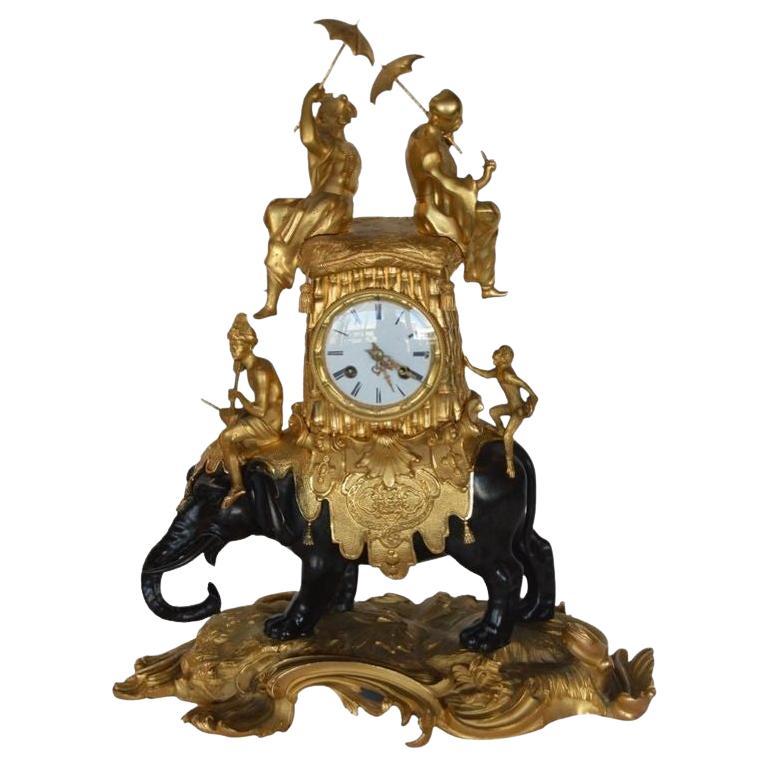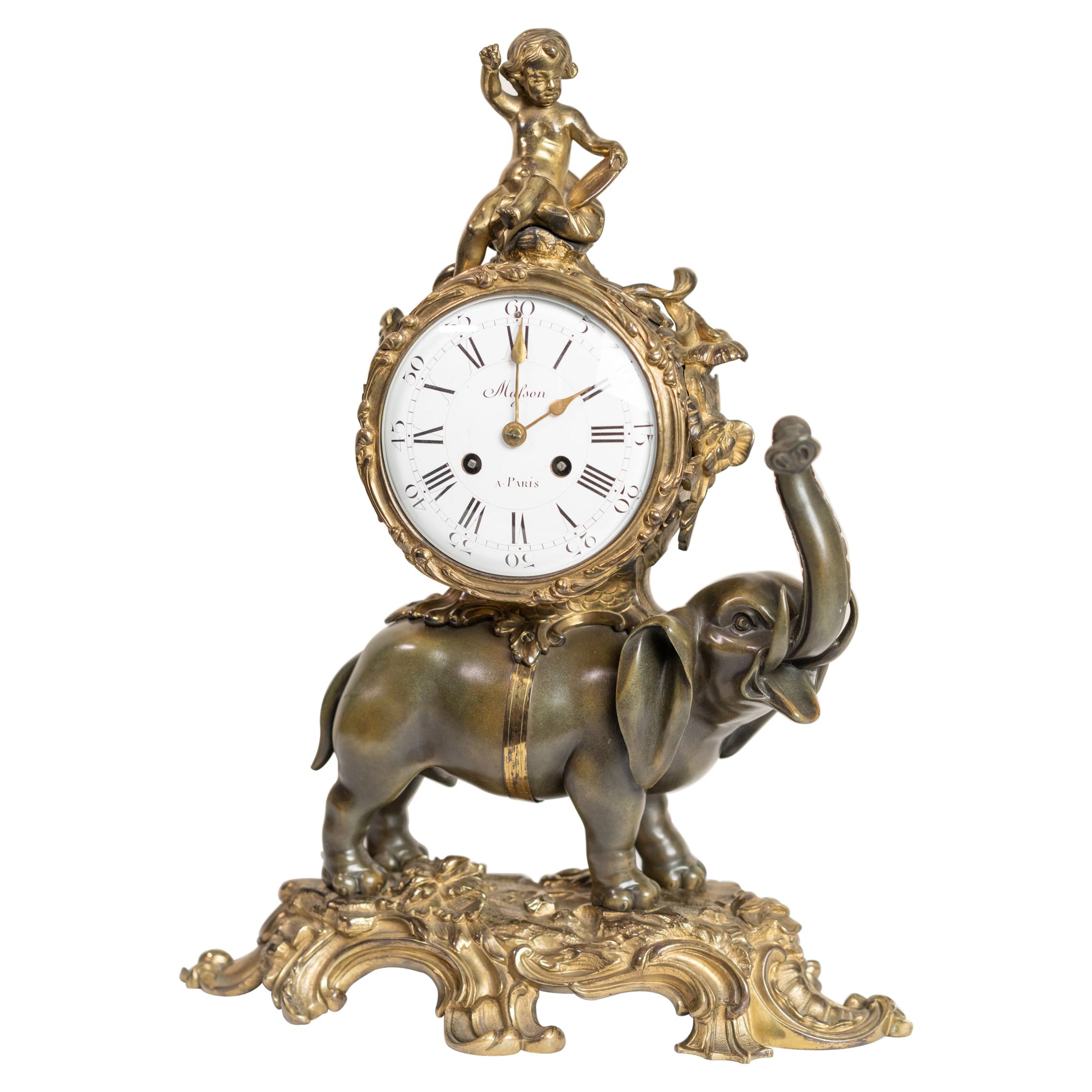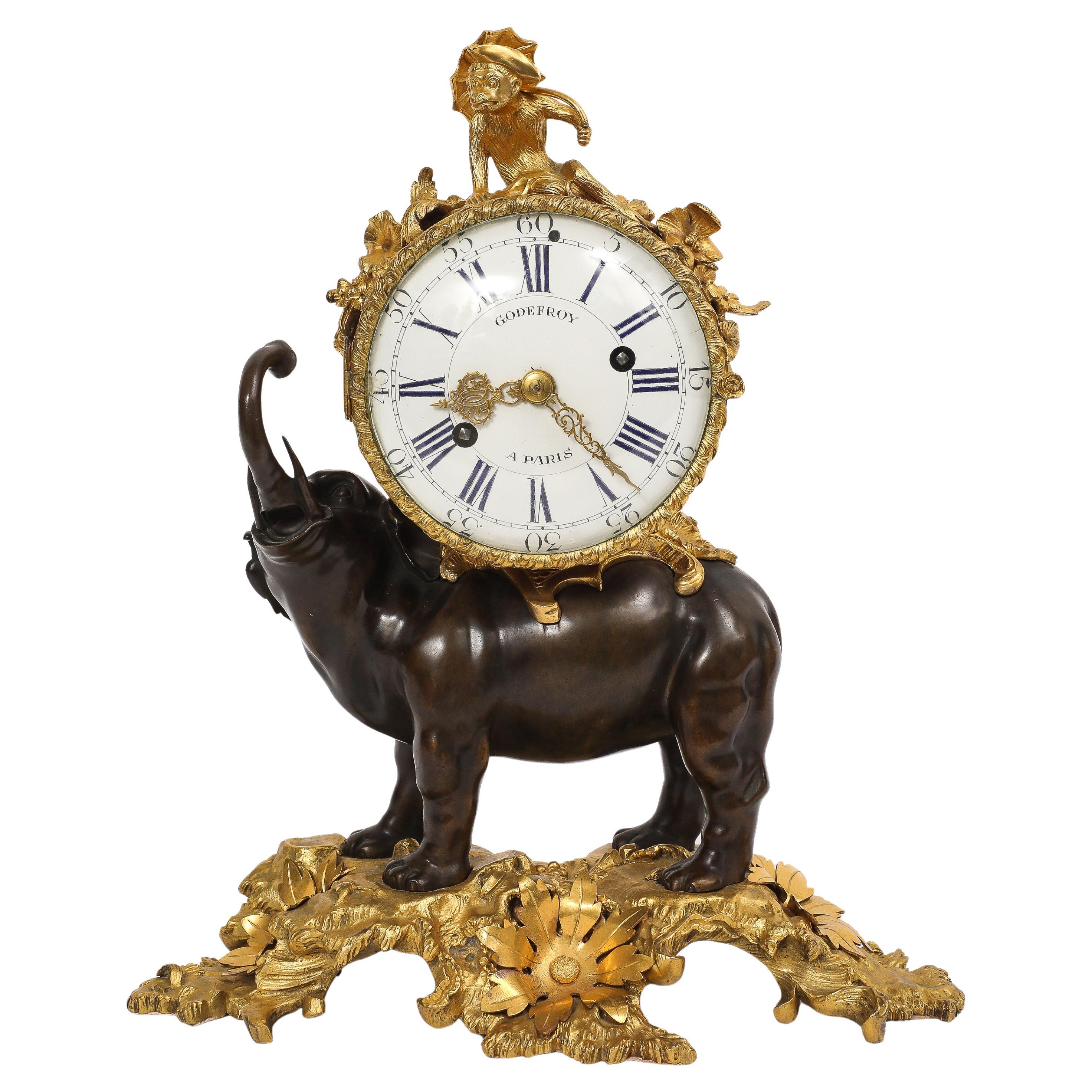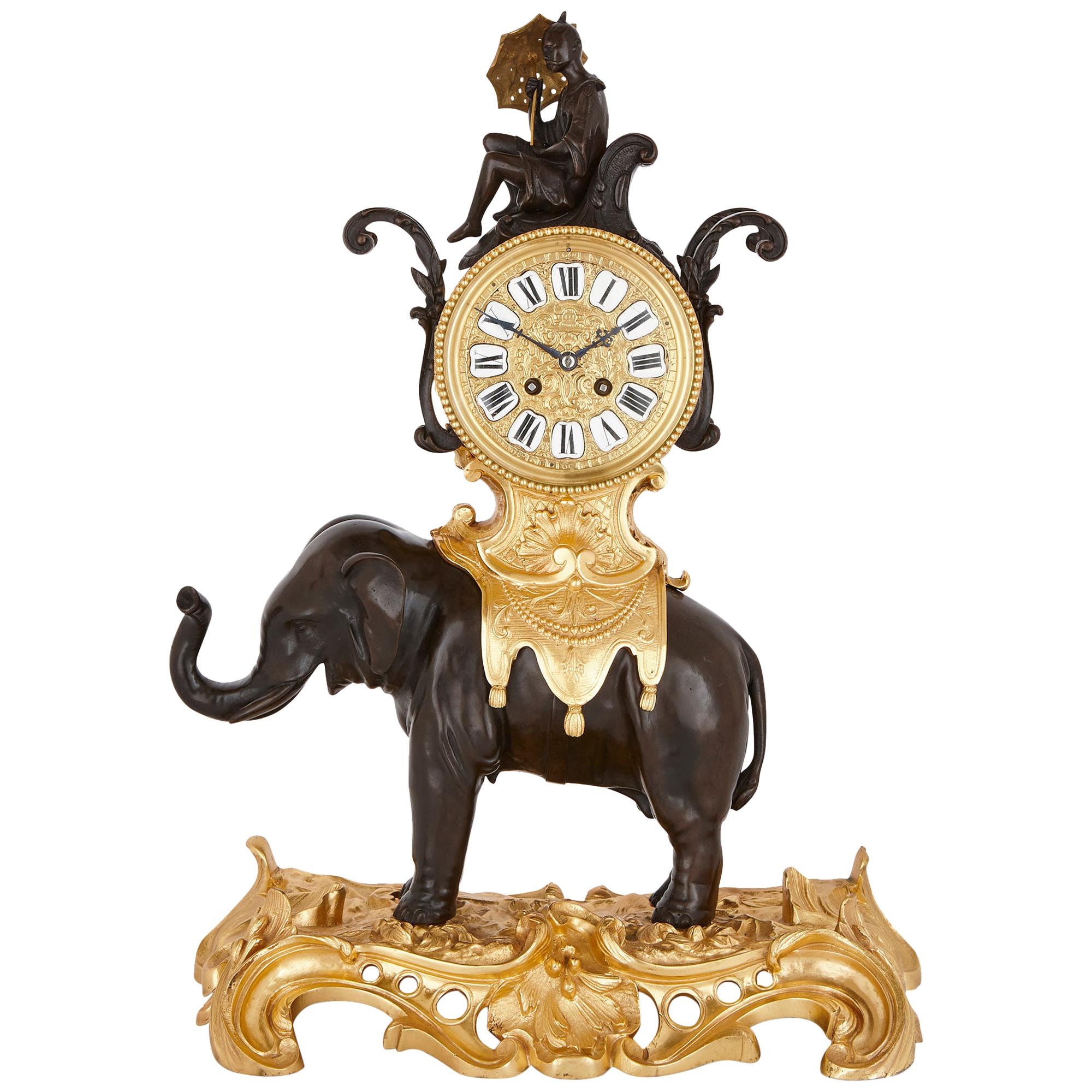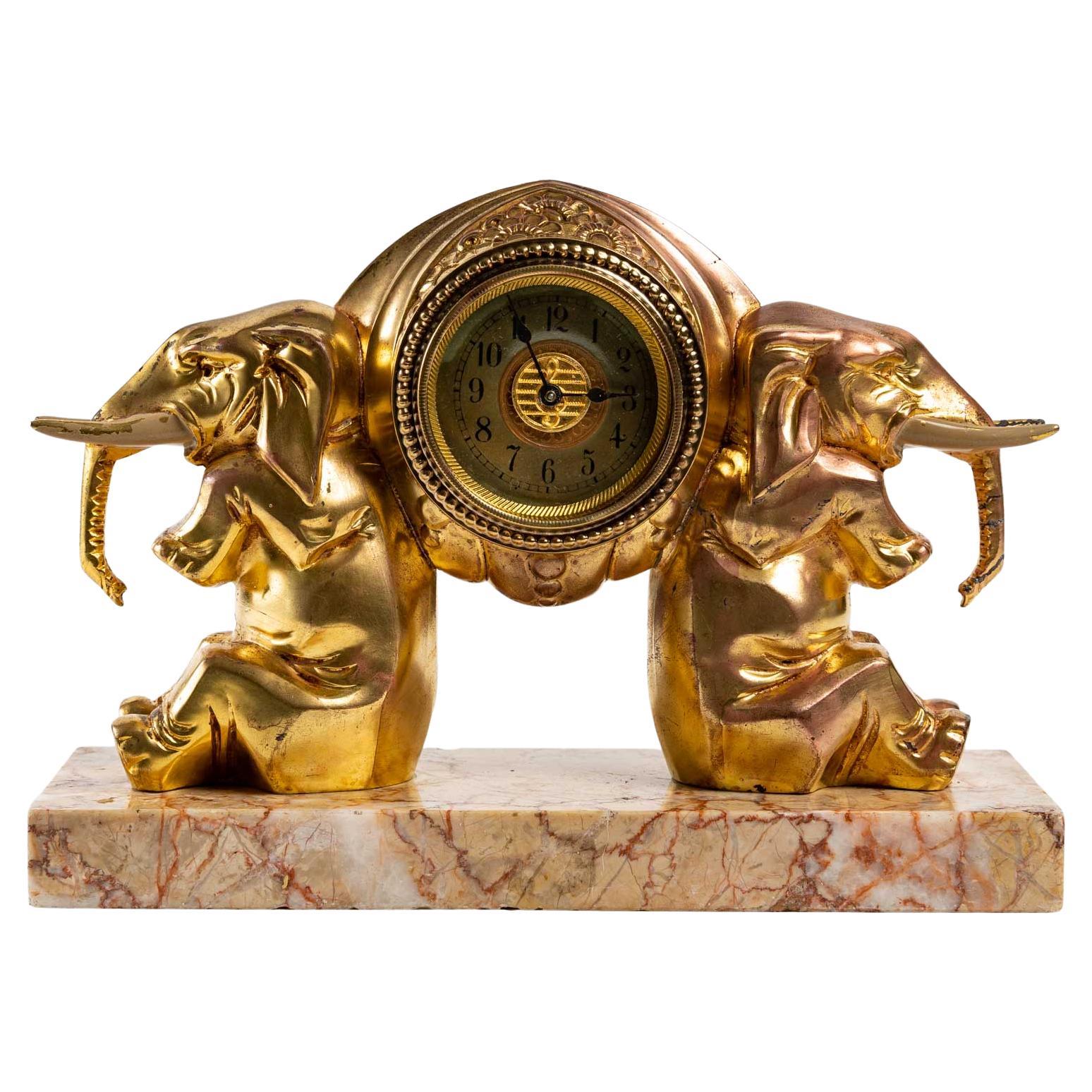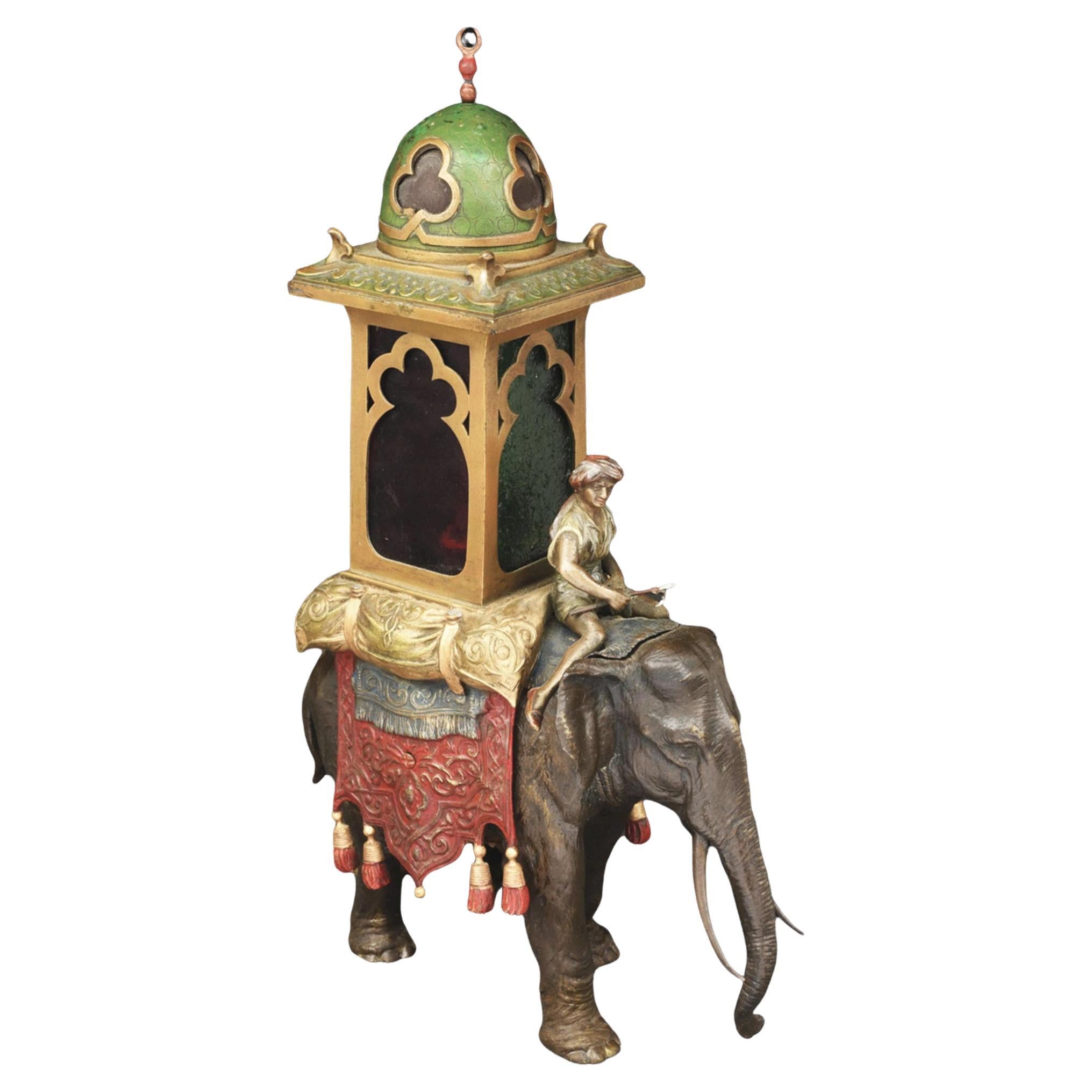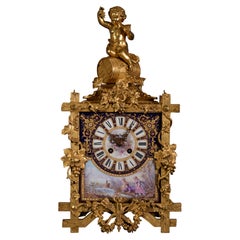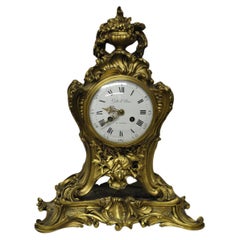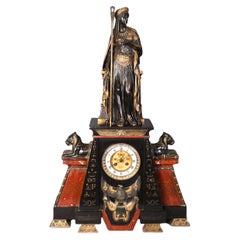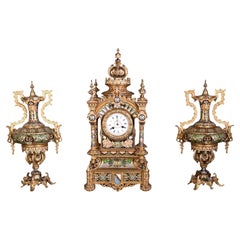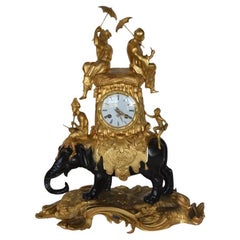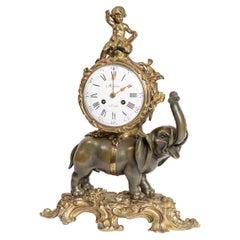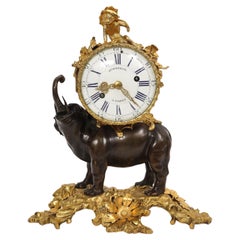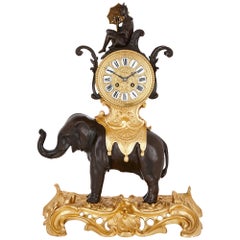Items Similar to Christophe FRATIN (1801-1864) rare Asian elephant clock, in gilded and patinated
Want more images or videos?
Request additional images or videos from the seller
1 of 7
Christophe FRATIN (1801-1864) rare Asian elephant clock, in gilded and patinated
$19,024.75
£14,270.03
€16,000
CA$26,558.42
A$28,765.95
CHF 15,235.72
MX$348,024.96
NOK 191,536.62
SEK 178,552.84
DKK 121,885.21
About the Item
France, circa 1870
Gilded and patinated bronze, modern marble base.
Signed « Fratin » on the bronze base
This beautiful elephant clock was made in the 19th century by the Animalier sculptor Christophe Fratin. From the reign of Louis XV, clocks representing animals have a great success. With the development of the taste for Orient, exotic animals fascinate and become privileged subjects for sculptors. From the 18th century, the elephant clock is a particularly popular model. Symbol of nobility, wisdom and power, this animal, discovered by the Europeans during the conquests of Alexander the Great, is often represented by Westerners carrying some monumental element on its back.
This image undoubtedly comes from the Eastern tradition of howdahs, Indian name of the pavilions installed on the back of the elephants to shelter travelers. On our clock, the pachyderm supports a heavy drum adorned with exotic flowers enclosing the clockwork. A Chinese character leads the elephant, one hand resting on the animal's head, the other holding a stick. Another character, feminine, is sitting cross-legged at the back of the drum, leaning against it. The dial supported by thick fabrics as well as the rod that surmount it bring verticality to the composition, evoking the monumentality of these animals that the Western imagination has often been pleased to represent. Among the many representations of this type, it is worth mentioning the Napoleonic project of the Elephant of the Bastille, a Parisian fountain that was never realized, but of which a plaster model at scale 1, built in 1814 near the site then destroyed in 1846, was notably quoted by Victor Hugo in a scene of Les Misérables staging the young Gavroche. This monumental fountain, whose creation had been entrusted to the architect Alavoine, was to be surmounted by the colossal statue of an elephant with a tower-shaped howdah.
All the Animalier sculptor talent of Fratin is perceptible in the representation of this elephant whose rendering of the epidermis is precise and realistic. The folds of the trunk and ears, the joints of its imposing legs and the look of the animal are particularly convincing. The fabrics which cover it are the occasion, for the artist, to demonstrate all his dexterity and his mastery; the care given to the treatment of the base is also to be pointed out.
After the revolution of 1848, the slowdown of the art market forced Fratin to turn to auctions to sell his works, mostly with cast rights, an extremely rare process for 19th-century sculptors. In the catalog of one of these sales (April 1850), there is a mention of an "Elephant, palanquin ride", which allows us to date the realization of our model before 1850.
- Creator:Christophe Fratin (Designer)
- Dimensions:Height: 16.93 in (43 cm)Width: 13.39 in (34 cm)Depth: 5.12 in (13 cm)
- Style:Napoleon III (Of the Period)
- Materials and Techniques:
- Place of Origin:
- Period:
- Date of Manufacture:1870
- Condition:
- Seller Location:SAINT-OUEN-SUR-SEINE, FR
- Reference Number:1stDibs: LU7662242390972
About the Seller
No Reviews Yet
Recognized Seller
These prestigious sellers are industry leaders and represent the highest echelon for item quality and design.
1stDibs seller since 2022
6 sales on 1stDibs
Typical response time: 1 to 2 days
- ShippingRetrieving quote...Shipping from: Revin, France
- Return Policy
More From This Seller
View AllNapoleon III Style Clock Made Out of Porcelain and Gilded Bronze
Located in SAINT-OUEN-SUR-SEINE, FR
This beautiful clock was made out of porcelain and gilded bronze during Napoleon III period. The porcelain dial indicates the hours with Roman numerals. It is decorated with gilded r...
Category
Antique 19th Century French Napoleon III Mantel Clocks
Materials
Bronze
Louis XV ormolu clock by Gille l'Ainé
Located in SAINT-OUEN-SUR-SEINE, FR
Beautiful little antique clock in the Louis XV style made by the clockmaker Gille l'Ainé in the 19th century. The dial is signed "Gille l'Ainé, à Paris". The curved forms, embellishe...
Category
Antique 19th Century French Louis XV Mantel Clocks
Materials
Bronze
Egyptian Revival Mantel Clock, 19th Century
By Georges Emile Henri Servant
Located in SAINT-OUEN-SUR-SEINE, FR
Mantel clock in patinated and gilt bronze, with red and black marble, in the Egyptian Revival style of the 19th century.
The composition features a standing female Egyptian figure h...
Category
Antique 19th Century French Egyptian Revival Mantel Clocks
Materials
Marble, Bronze
Persian-style double-sided clock and garnitures, Charles Stanislas MATIFAT
By Charles Matifat
Located in SAINT-OUEN-SUR-SEINE, FR
Charles Stanislas Matifat is the creator of this ensemble consisting of a double-sided enameled bronze clock and a matching pair of large garnitures. Dated 1851 and bearing his signa...
Category
Antique 19th Century European Islamic Table Clocks and Desk Clocks
Materials
Bronze, Enamel
A ceremonial cigar display stand in honor of the Imperial Prince Napoleon IV
Located in SAINT-OUEN-SUR-SEINE, FR
This exceptional cigar display stand, crafted from mahogany-stained wood, is richly carved and composed of three distinct elements. Taking the form of a small shrine, the central ele...
Category
Antique 1870s French Napoleon III Cigar Boxes and Humidors
Materials
Wood, Elm
Arthur WAAGEN Japanese-style clock set
Located in SAINT-OUEN-SUR-SEINE, FR
By Arthur WAAGEN (active 1869-1910).
Japanese-style clock set. Made out of spelter.
Representing a young woman dressed in a kimono
Category
Antique 19th Century French Japonisme Mantel Clocks
Materials
Ormolu
You May Also Like
19th C Louis XV Style Gilt Bronze Elephant Clock Signed by Barreau F. de Bronzes
Located in Los Angeles, CA
A magnificent Louis XV style French gilt bronze elephant clock, signed by Barreau F. de Bronzes, dating to the 19th century. This highly decorative timepiece exemplifies the elegance...
Category
Antique 19th Century French Mantel Clocks
Materials
Bronze
Rare Louis XV Style "Elephant" Bronze Mantel Clock
Located in Montreal, QC
Rare Louis XV style gilt and patinated bronze "Pendule à l'éléphant" mantel clock , the enamel dial signed: "Mafson" à Paris"
This beautiful example was made in the late 19th century...
Category
Antique 1880s French Louis XV Mantel Clocks
Materials
Bronze
Louis XV Clock, 1750s Paris Ormolu & Patinated, Pendule à lÉléphant; by Godefroy
Located in New York, NY
A remarkable example of mid-1700's French horology, this Louis XV period Pendule à l’Éléphant showcases the technical mastery and playful elegance characteristic of the Rococo era in...
Category
Antique Mid-18th Century French Louis XV Mantel Clocks
Materials
Bronze, Ormolu
Antique Louis XV Style Patinated and Gilt Bronze Clock
Located in London, GB
Designed in a fanciful Louis XV style, this beautiful mantel clock takes the form of an Asian elephant, saddled with a howdah (carriage). The clock features a patinated sculpture of ...
Category
Antique 19th Century French Louis XV Mantel Clocks
Materials
Enamel, Ormolu, Bronze
$14,278 Sale Price
30% Off
Small Clock with Elephants
Located in Saint-Ouen, FR
Desk clock with elephants, early 20th century, Art Nouveau.
Measures: H: 16 cm, W: 21 cm, D: 8 cm.
Category
Vintage 1910s French Art Nouveau Table Clocks and Desk Clocks
Materials
Marble, Metal
$1,331 Sale Price
20% Off
Austrian Cold Painted Bronze Elephant Lamp
Located in New York, NY
A beautiful Austrian cold painted bronze lamp. The 16” tall lamp with middle eastern motif, feature a large, bronze elephant being ridden by a ma...
Category
Antique 19th Century Austrian Table Lamps
Materials
Bronze, Enamel
$11,200 Sale Price
20% Off
More Ways To Browse
Asian Elephants
Antique Bronze Elephant
Elephant Base
Asian Table Gold
Elephant Statue
Antique Elephant Table
Fratin Bronze
French Bronze Elephant
Elephant Desk
Bronze Elephant Table
Antique Elephant Statues
Gilt Bronze Elephant
Elephant Howdah
Elephant Clock
Les Miserables
Elephant Clock Bronze
Clock Angel
Cylinder Clock
